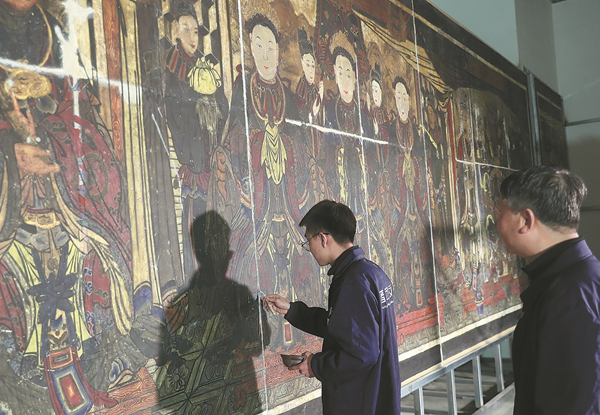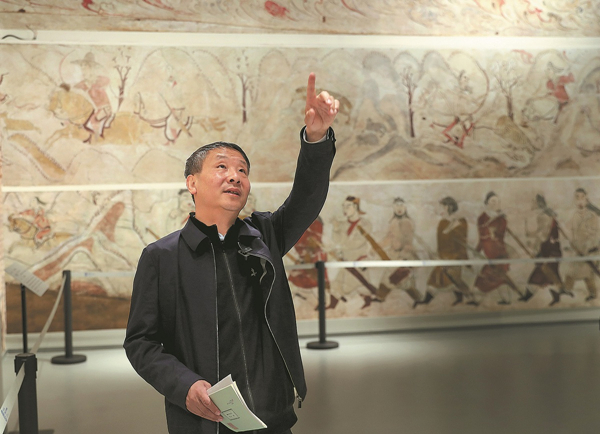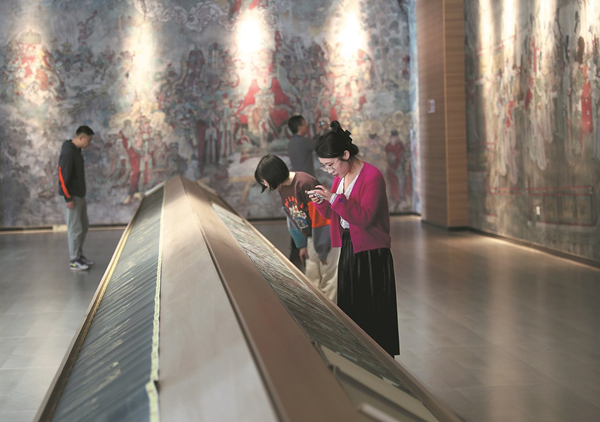A life dedicated to frescoes
Updated: 2023-05-04

Museum staff members repair exhibits. [Photo by Zou Hong/China Daily]
Determined to highlight the richness of Chinese history and culture, Liu Guohua has been mapping and digitalizing frescoes scattered in temples around Shanxi province, write Sun Ruisheng in Taiyuan, Shanxi, and Li Yang in Beijing.
Liu Guohua, 53, attributes his interest in history and culture to his teacher parents and erudite grandfather, who practiced calligraphy and read and collected thread-bound "old texts".
Today, Liu owns the largest private museum in Jinzhong, Shanxi province, complete with "digitalized frescoes", as well as a company that specializes in cultural products.
"As a young boy, I loved watching the traditional opera performed at the temple fair. I even wanted to join the troupe to learn the art," Liu said about his childhood in Ningwu, Shanxi.
Inherent love for books
Liu has been a bookworm since his primary and middle school days, and had his dream to get admitted to the Shanxi Normal University fulfilled in 1991. He majored in Chinese language and literature.
His father died when he was just 15. So to ease his mother's burden of taking care of Liu and his three brothers and sisters, he took up a part-time job while still preparing for his college graduation.
Working as the editor for the literary supplement of the university's newspaper during his third and fourth year of college, he gathered enough experience to win a work contract with the Shanxi Economic Daily after graduating in 1994.
Over the following decade, he traveled across the province, which is known for its massive coal reserves and a large number of historical relics. That work experience helped him to better appreciate the cultural and historical wealth of his hometown.
A crossroad of different cultures
Situated in the middle reaches of the Yellow River in North China, Shanxi is not only a cradle of Chinese civilization but also located at a crossroad of different cultures, with the Inner Mongolia autonomous region to its north and Northwest China to its west, leading to the Xinjiang Uygur autonomous region and Central Asia (as well as South Asia). As a result, it has many temples and grottoes scattered across its rugged landscape.
Liu recalled his "first encounter "with the "beautiful but ill-maintained" frescoes, which according to him, was a "life-changing experience", in Kaihua Temple in Shanxi's Gaoping, the hometown of his then classmate and girlfriend Qiu Junling, who is now his wife, in 1993.The temple was built in 571, and famous for its frescoes that were painted during the Song Dynasty (960-1279).
Qiu said: "The temple is near my home. I often visited it with my grandparents. I was fascinated by it. But I didn't know much about it beyond what the old villagers told us children at the time. Since I thought it's a place worth seeing, I took him (Liu) there."
Liu added: "Although I had seen some frescoes in some temples in my hometown as a child, this was the first time I really stood in front of such a large and magnificent fresco. The frescoes of Kaihua Temple were deeply imprinted on my mind." After working as a reporter for about a decade, with the support of his wife, Liu founded his own company, designing and making cultural products as well as handicrafts and souvenirs.

Liu Guohua describes the frescoes at the museum. [Photo by Zou Hong/China Daily]
Tourism helped make Liu's business a success
Thanks to the explosion of tourism in Shanxi, Liu's business turned out to be a success, not least because he was one of the early birds in the market.
After reading some books on the frescoes in Shanxi by then chief engineer of the Shanxi cultural relics bureau, Chai Zejun, in 2008, Liu's memory about the beautiful frescoes in Kaihua Temple was revived. Chai's observation that the history of Chinese frescoes would not be complete without the frescoes in Shanxi — and that the frescoes in the Mogao Grottoes in Dunhuang, Gansu province, didn't represent the entire gamut of frescoes in China — prompted Liu to devote more attention to the frescoes in Shanxi.
"I just wanted to make the frescoes an element of my cultural and creative products. Later, when I began appreciating the charms of ancient art, I felt obliged to show their beauty to more people," Liu said.
Can today's artists imitate old paintings?
Liu consulted Yuan Yougen, a professor of fine arts at his alma mater, about his business plan. But Yuan told him that given the huge amount of work it involves, it's mission impossible for any artist to copy the frescoes in Shanxi, even if those that had survived the vagaries of the weather or had been painted over in the name of restoration, because they accounted for only a small percentage of the total. Yuan also doubted whether contemporary artists could imitate the old paintings.
Despite that, Liu didn't give up. After hearing in the spring of 2009 that a national museum in Beijing had copied ancient art works using digital technology, Liu spent over 1 million yuan ($145,100) to buy a high-precision digital scanner from Germany.
But after he got the machine, he found that the scanner, being immovable, was not suitable to scan frescoes. It could be used only to scan paintings and calligraphy works. "Fresco scanning is a demanding job, as the space could be cramped, and some frescoes are eight or nine meters high from the ground. The lens and the surface of the frescoes must be kept parallel to each other at a certain distance to ensure accurate imaging," Liu said.
After that, Liu assembled a set of equipment for the job, which comprised lenses from Germany, a scanner from Sweden and precision camera supports from Italy. The frescoes in Kaihua Temple were his first experiment, and they proved to be a success. "It is very difficult to scan the frescoes. There are so many temples in Shanxi, and they are scattered across the province including in remote mountainous areas," Qiu said.
"Sometimes, we stayed inside the temples for days under extremely tough conditions," she added.

Visitors view digitalized replicas of frescoes at the Fresco Art Museum in Jinzhong, Shanxi province. [Photo by Zou Hong/China Daily]
Endeavour reminds of pioneering researchers
After climbing on the beams of the main hall of the Foguang Temple in Wutai Mountain in Xinzhou, Shanxi, in 2010, to scan the frescoes, Liu said the thick layer of dust, spider webs and bat droppings reminded him of Liang Sicheng and Lin Huiyin, two researchers of ancient Chinese buildings and historians, who conducted field studies on temples and other relic sites in the province in 1937.
"Those might be the beams where the two famous architects once stood more than 80 years ago, as their diaries mentioned the bats and their droppings, too," Liu said.
"They (Liang and Lin) sketched the structures with pen at that time... Now we have world-class equipment to do the job. There is no reason why our generation should not make due contribution of our generation to the maintenance of historical heritage and let more people know about it."
Extensive scanning of frescoes in Shanxi
In the 14 years since 2009, Liu and his team have scanned and digitalized frescoes in 332 national-level cultural relic sites and more than 200 provincial-level cultural relic sites in Shanxi, which add up to more than 20,000 square meters of ancient frescoes. Liu's team has done the digital imaging and mapping of about half of them.
"Many of the frescoes we scanned have disappeared due to theft, natural disasters and climate change over the years, so the rich database we are building becomes more meaningful," Liu said.
Liu hopes the provincial authorities will offer more support for cultivating and attracting more talents for the digitalization of cultural relic sites. "Technology and equipment are no longer problems. Yet the amount of work to be done dwarfs the number of professionals in the province, and the work needs to be done with urgency," Liu said.
Liu plans to make his museum a platform for researchers, scholars and students of archaeology, arts and architecture, and include not only frescoes but also ancient buildings and other cultural relics for research.
Peng Ke'er in Taiyuan contributed to the story.
Contact the writers at sunruisheng@chinadaily.com.cn



